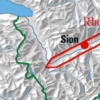Overview
The Moose Creek Dam is an earthfill embankment dam located on the Moose Creek in Fairbanks, Alaska. The dam was built in the early 1960s to provide flood control and water supply for the city of Fairbanks.
The Moose Creek Dam is owned and operated by the U.S. Army Corps of Engineers (USACE), who built the dam as part of their flood control program in the Tanana River Basin. The dam has a height of 23 feet and a length of 860 feet, with a maximum capacity of 25,000 acre-feet of water.
The Moose Creek Dam plays a vital role in the energy infrastructure of the Fairbanks area. The dam generates electricity to power homes in the region and helps to meet the energy demands of Fairbanks’ growing population. The dam also provides important flood control measures for the Chena River, which is known to experience periodic flooding during the spring and summer months.
Flood Control
When the water surface upstream of the dam reaches an elevation of 495 feet Mean Sea Level (MSL), water begins to flow over the natural riverbanks and into the floodway toward the Tanana River. If water rises to over 500 feet MSL, during extreme flood events, the impounded water flows over an ungated floodway and directly into the Tanana River, effectively diverting the excess water to reduce potential damage.
In 2014, two flood events took place within one month of each other. While they were both relatively minor, the flooding prompted an overview of the dam conditions, safety hazards, and measurement of groundwater levels.
Instrumentation
Piezometer wells located along the dam were implemented in order to monitor embankment water levels, improving the ability to detect developing dam safety issues. In order to monitor flood control and water levels, the USACE collected data remotely and used excel to generate reports for further analysis and investigation of embankment water levels. The piezometers were spaced far apart along the 7.5-mile-long dam embankment, making manual data collection less than ideal.
What We Did
The Corps of Engineers Alaska District decided to automate the data collection process by logging and posting the piezometer data through a networked system that would aggregate the data in a central location. Using MutliLogger, the Windows based application for automatic programming of instruments, site personnel were able to program and manage the data loggers. The application is designed to provide a seamless experience that automates the process of instrument programming and data collection while providing accurate data from multiple instruments.
Canary Systems’ web-based monitoring system, MLWeb, provides the AK District with remote access to dam safety data that improves monitoring capabilities and data accuracy. The monitoring system enables off-site personnel to remotely keep track of water levels and seepage in high-risk areas. Additionally, they are alerted of any emerging concerns during a flood event.


